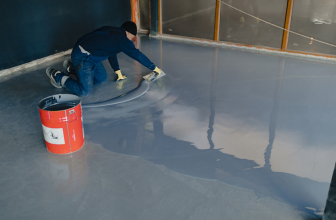Tips for Applying Epoxy Coatings in Cold Weather

Tips for Applying Epoxy Coatings in Cold Weather! Epoxy coatings are a popular choice for protecting and enhancing various surfaces, from garage floors to industrial facilities. They provide a durable and attractive finish that can withstand heavy traffic, chemicals, and other environmental factors. However, applying epoxy coatings in cold weather can present challenges and affect the overall quality and performance of the coating. In this article, we will discuss seven essential tips to help you successfully apply epoxy coatings in cold weather conditions.
Table of Contents
ToggleTips for Applying Epoxy Coatings in Cold Weather
Here are some tips for applying epoxy coatings in cold weather.
Check the Temperature Requirement
Before starting any epoxy coating project, it is crucial to review the manufacturer’s guidelines regarding temperature requirements. Different epoxy products have specific temperature ranges in which they can be applied and cured effectively. Typically, the recommended temperature for applying epoxy coatings ranges from 50°F to 90°F (10°C to 32°C). Ensure that the ambient and surface temperatures fall within this range and remain consistent throughout the application and curing process.
Warm Up the Environment
Cold temperatures can significantly impact the curing process of epoxy coatings. To create a more favorable environment for the coating application, it is essential to warm up the space. Use space heaters or other heating methods to increase the ambient temperature. Avoid using open flame or propane heaters, as they can introduce moisture and affect the coating’s performance. The goal is to maintain a consistent temperature throughout the application and curing period.
Preheat the Surface
In addition to warming up the environment, preheating the surface can help ensure proper adhesion and curing of the epoxy coating. Cold surfaces can hinder the flow and self-leveling properties of the epoxy, leading to uneven coverage and potential bonding issues. Use infrared heaters or heat lamps to gently warm up the surface before applying the epoxy. This step helps reduce the viscosity of the epoxy, allowing it to spread more easily and adhere properly.
Use Low-Viscosity Epoxy
In colder temperatures, epoxy coatings tend to become thicker and more challenging to work with. To compensate for this, consider using a low-viscosity epoxy formulation specifically designed for cold-weather applications. Low-viscosity epoxies have a thinner consistency, making them easier to mix, apply, and self-level even in colder temperatures. These formulations also have a faster curing time, which can be beneficial when working in cooler conditions.
Extend Pot Life
Pot life refers to the amount of time the epoxy remains workable after it has been mixed. In cold weather, the pot life of epoxy coatings can be significantly reduced. To extend the pot life and allow more time for application, consider using epoxy systems with longer pot life properties. These formulations are specifically designed to withstand lower temperatures and provide an extended working time, ensuring that the coating can be applied properly before it begins to cure.
Use Accelerators
Accelerators are additives that can help speed up the curing process of epoxy coatings in cold weather. These additives are mixed with the epoxy resin and hardener and can reduce the curing time by increasing the reaction rate. By incorporating accelerators into the epoxy mixture, you can ensure that the coating cures properly even in colder temperatures. However, it is essential to follow the manufacturer’s recommendations and not exceed the recommended dosage to avoid any negative effects on the coating’s performance.
Allow Sufficient Curing Time
Curing time is crucial for the proper development of epoxy coatings. In cold weather, epoxy coatings generally require a longer curing time compared to warmer conditions. It is essential to allow sufficient curing time as specified by the manufacturer before subjecting the coated surface to foot traffic, heavy loads, or other stresses. Rushing the curing process can lead to premature failure and compromise the durability and performance of the coating.
Conclusion
In conclusion, applying epoxy coatings in cold weather requires a different approach than during warm weather. It is important to prepare the surface and use the correct tools and materials. The temperature, humidity, and dew point must be taken into account to ensure proper curing and adhesion of the coating. By following the tips outlined above, you can successfully apply epoxy coatings in cold weather conditions and achieve a durable, long-lasting finish. Don’t let the chilly temperatures deter you from completing your project; embrace the challenge with confidence and skill!








